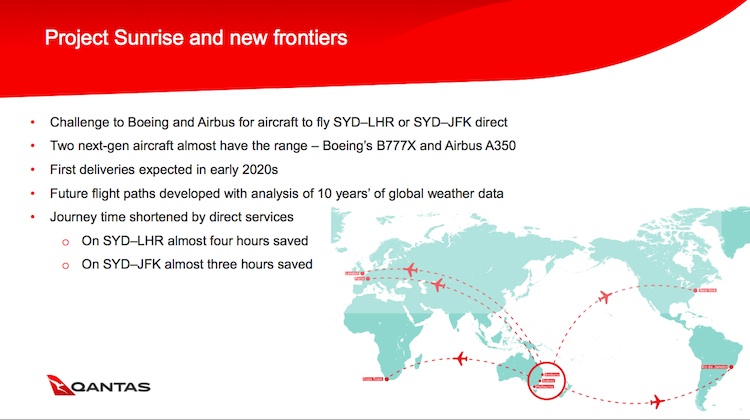
Boeing Commercial Airplanes managing director for product marketing and analysis Jim Freitas says the manufacturer is working hard to understand Qantas’s requirements for “Project Sunrise” as it pitches the in-development 777-8X widebody to operate the proposed ultra-long haul routes.
Project Sunrise – the name is a nod to the “Double Sunrise” flights Qantas operated between Perth and Sri Lanka using Catalinas in WW2 – pits Boeing’s 777-8X against the A350-900ULR from Airbus in a two-horse race for Qantas’s plans to serve New York and London, among other destinations, nonstop from Australia’s east coast.
Freitas says the 777-8X project is progressing on schedule, with Boeing’s Everett composite wing centre up and running and the first spars loaded earlier in October. Entry-into-service was scheduled for 2022.
Further, Boeing engineers are currently in dialogue with Qantas to determine the requirements for those ultra-long-haul journeys and what that would mean for the design of the aircraft.
“When airlines want to use our aeroplanes to the limit of their capability, as an aircraft designer nothing makes you more excited,” Freitas told reporters during a media briefing at Everett on Sunday (US time). “That’s an incredible challenge.”
“Absolutely we know that the airplane can make the range today, it is just with how many passengers at what weight assumptions, how much cargo and that kind of thing.
“Does the capability of the airplane today make the requirements that Qantas has or do we have to add something else to that to be able to make that range.”
While the headline routes for Qantas’s Project Sunrise are the nonstop flights to London and New York, the airline has indicated its ultra long-haul ambitions extend to four continents of the globe.
Qantas chief executive Alan Joyce says Airbus and Boeing come close in terms of meeting the mission of a full passenger and cargo payload in both directions for London and New York from Australia’s east coast capitals of Brisbane, Melbourne and Sydney, as well as points in South America and South Africa.
“We think this challenge is feasible,” Joyce told reporters at Boeing’s Everett plant on Sunday (US time).
“From our perspective, the critical thing is to get it with full payload. We want the full capability of the 777-8X on those routes with full passenger payload and full freight payload.”
(The airline has invited journalists, including Australian Aviation to Seattle for events leading up to first delivery of its first Boeing 787-9. The first Qantas 787-9, VH-ZNA, is due to touch down in Sydney on Friday morning.)

While most of the initial focus when Project Sunrise was publicly launched in August was on London Heathrow (9,188nm from Sydney) and New York JFK (8,647nm), Qantas has also earmarked Rio de Janeiro in Brazil (7,312nm) and Cape Town (5,946nm) in South Africa as new frontiers for nonstop service.
And Joyce has publicly stated a desire to mount nonstop flights to other European points beyond London, such as Paris and an unspecified city in Germany.
“We’d love to be able to fly directly into Brazil, into Rio and we’d love to be able to fly directly into Cape Town,” Joyce said.
“Existing technology doesn’t allow us to do that. While the aircraft is close, it’s not quite there.”
Currently, the world’s longest route by distance is Qatar Airways’ Doha-Auckland service at 7,848nm, operated by Boeing 777-200LR equipment.
While it is true the Boeing 777-8X and Airbus A350-900ULR are capable of operating those routes, the range versus payload specifications were not quite where Qantas believed they needed to be for either airframes to ensure the routes were economically viable.
The Boeing website lists the 777-8X as having a range of 8,700nm and a passenger capacity of 350-375 passengers. The aircraft is expected to enter service in 2022.
However, the final specifications will only be known after further development of the aircraft design and an analysis of its General Electric GE9X engines.
Meanwhile, Airbus has not published specific technical data on the A350-900ULR, stating only the long- range variant was capable of flying 19 hours and carry up to 165,000 litres of fuel. By comparison, the standard A350-900 has a range of 8,100nm and could take on 141,000 litres of fuel.
Although Qantas has not spelled out its specific requirements for passenger count and cargo, preferring only to say a full payload was the target, Joyce did offer one little detail about the potential cabin layout.
“Our ideal is to have all of our classes on board the aircraft,” he said.
“We know there is a certain demand for business, we know there is a certain demand for premium economy.
“And we know we have to have economy on the aircraft to make the economics work. The prices will be competitive.”










